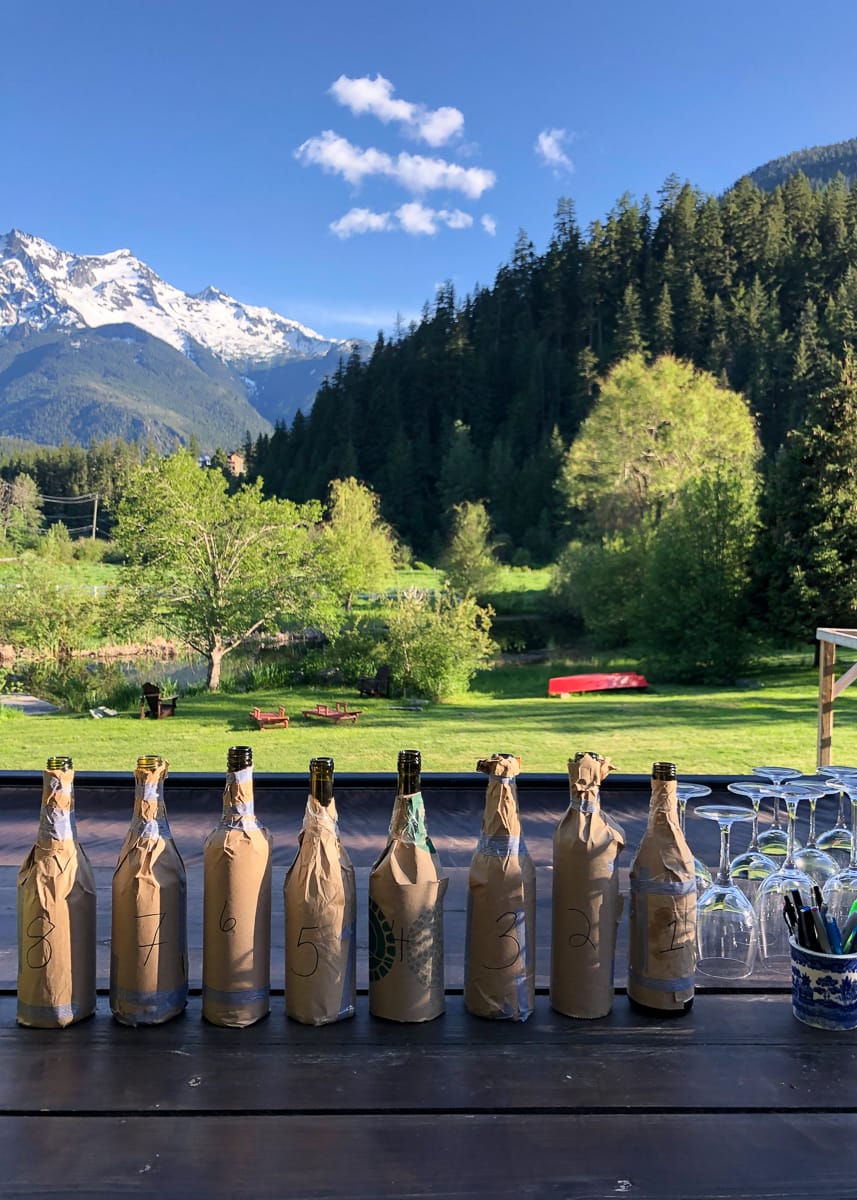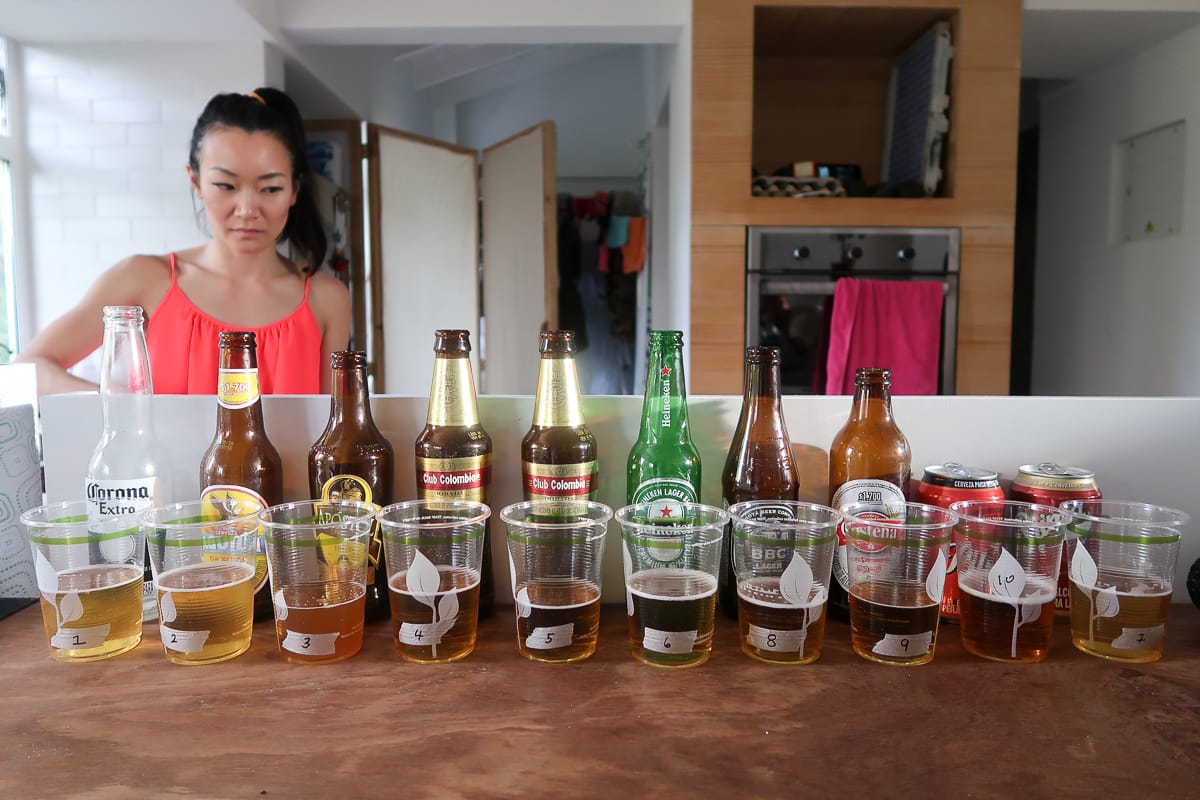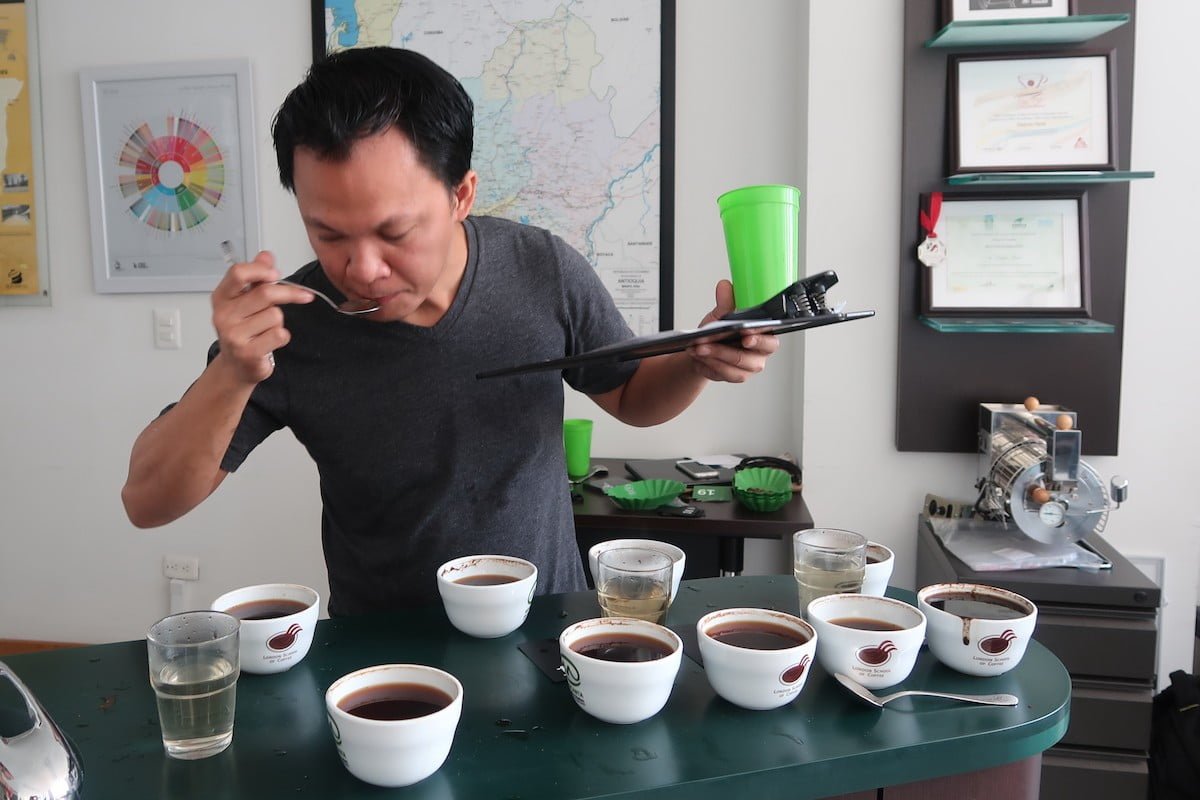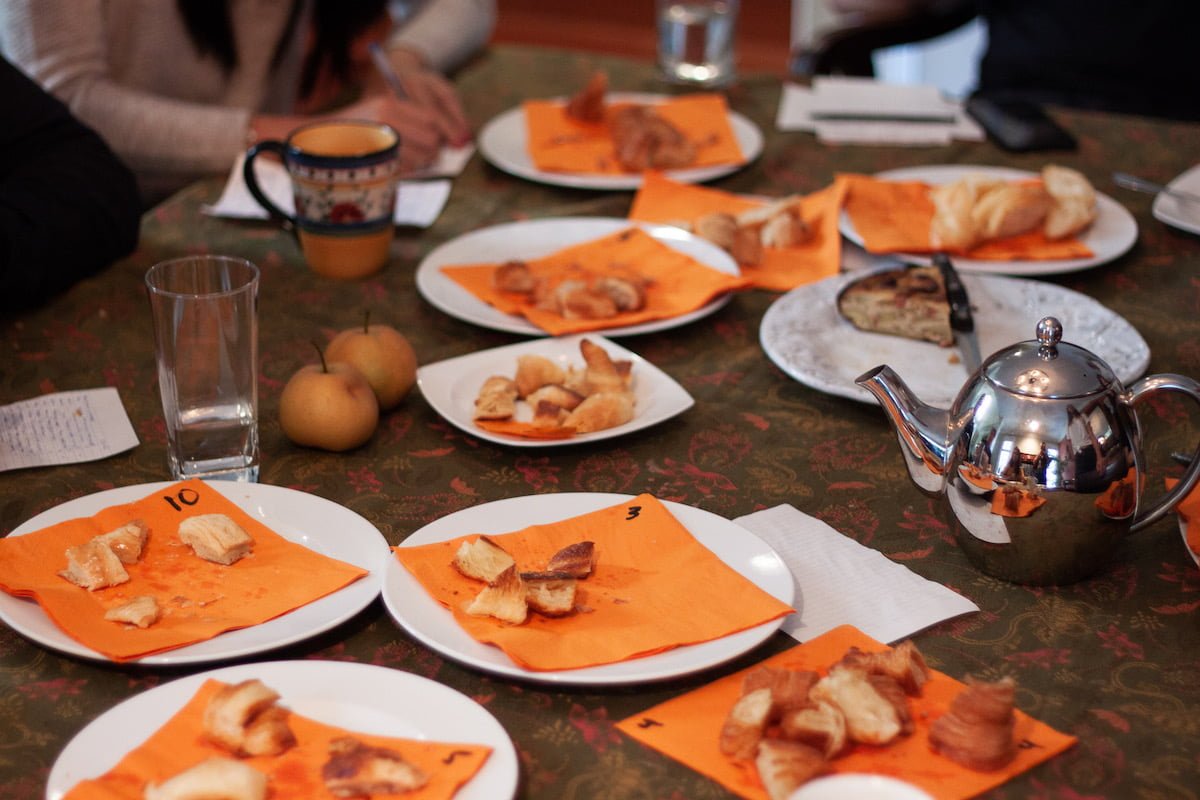How to Have Great Taste (Tests)
Kim and I love hosting blind taste tests.
It’s our go-to move to:
- Make friends and learn about new foods when we move to new cities,
- Settle debates on who has the best ice cream, beer, or whatever,
- Refine our palettes, and,
- Enjoy memorable evenings without too much work.
And, maybe most importantly, blind taste tests are a helpful reminder to keep challenge the status quo, which is what we’re all about on The Zag.
In This Blind Taste Test Guide:

How to Conduct a Blind Taste Test
1. Pick a Product
Wine blind taste tests are the most common, but you can taste test anything. See our blind taste test ideas in the next section for inspiration.
2. Narrow it Down to One Variable
That variable may be price, varietal, type, or brand.
Whatever you decide, try to limit the number of products to seven. (See F.A.Q. to find out why.)
3. Invite
The most fun blind taste tests we’ve hosted had a diverse group of tasters:
- Expertise: from true connoisseurs (a.k.a. snobs) to indiscriminate novices.
- Background: People from different countries and with different tastes and habits.Emphasize to all invitees the extra importance of arriving on time because the blind taste test can’t start until everyone has arrived.
4. Prepare
Tidy up your home if you’re the one hosting the blind taste test, prep the snacks (see F.A.Q.), and set the table.
Here’s a quick checklist:
- Something to cover the products being taste-tested.
- Glasses, cups, or plates for everyone.
- A pen and paper for each taster.
- Water for mouth rinsing and hydrating.
- A pre-prepared computer spreadsheet for consolidating the results and declaring a “winner” (if you’re a big nerd like Chris).
- Prep everything you’re going to be taste-testing, aside from what your guests will be bringing.
5. Welcome
Welcome your guests as they wait for the others to arrive by preparing a welcome drink (non-alcoholic if you’re tasting booze) and a snack.
6. Disguise
Cover up each product—or even better put them all in identical serving containers—and number them.
Only one person should do the disguising, generally the blind taste test host.
7. (Optional) Throw in a Twist
Spice up your blind taste test with a curveball. Include two of the exact same product to test how consistent people’s tastes are.
Or throw in something completely different, like a white wine amongst red wines (if blindfolded), or a veggie burger amongst the beef.
Whatever your twist, don’t tell the taste testers.
8. Explain
Get everyone seated and ready and explain how you will conduct the blind taste test: how many products they will taste, how they are expected to score each product, and tips on what to write in the comments (see below), and…
Most importantly, tell them the #1 rule of conducting blind taste tests: No talking about the products while tasting. You don’t want one’s opinions and reactions to affect everyone else’s.
9. Taste
Tip: Do side-by-side comparisons of two products at a time to more easily identify the differences between the products and rank them.
10. Comment
The tasters should write as much as they can about each product.
Longer, more descriptive comments make it easier for tasters to remember and compare the products and make it more fun to share and discuss results afterward.
11. Rank or Rate
Each taster scores or ranks the products. (See F.A.Q. for why we recommend ranking over scoring.)
The easiest way we’ve found to rank is group the products by bucket (good, ok, and bad) in your first round of tasting, then do a second round of tasting (and third, and fourth…) to rank the products within those bucket
12. Discuss
To avoid a chaotic discussion, it’s best if the host moderates.
Starting from product number one, go around the table asking each taster what their comments were and how they rated or ranked it. Move on to product number two, and so on.
13. (Optional) Consolidate and Crown
Consider consolidating everyone’s ratings or rankings into a computer spreadsheet to come up with an overall blind taste test winner and loser.
Email it to the tasters afterward as a souvenir and for their future reference.

Blind Taste Test Ideas
Here are some fun blind taste test ideas to try:
- Beer. Can you tell Heineken from Corona? A honey ale from a golden ale? A Budweiser from a $5 craft lager? Canned beer vs bottled?
- Coffee. Which roast do you prefer? How do Starbucks and McDonalds compare to a local roaster? See our Medellin coffee taste test for inspiration.
- Cheese. Test different brands of the same type of cheese (like cheddar, or Colombian cheeses), or test a variety of types.
- Chocolate. Which level of darkness do you prefer? Which brand makes the best chocolate of a specific darkness level?
- Croissants. Does a day-old croissant taste that much worse than a fresh one? Does the high-end French bakery make them better than a big supermarket?
- Eggs. Do free-range, pasture-fed chicken eggs taste different from industrial ones? Do brown and white eggs differ?
- Hamburgers. Which of your friends can make the tastiest burger? Can you tell real meat from imitations like Beyond Meat and the Impossible Burger?
- Ice cream. Will Häagen-Dazs chocolate ice cream whoop hipster-favorite artisanal ones, like we found?
- Liquor. Is Grey Goose vodka any better than Costco’s Kirkland brand? Is a 1-year-aged rum better than a 23-year-aged one?
- Sushi. Does real crab taste any better than imitation crab in a California roll? Is the all-you-can-eat sushi place’s product really that much worse than the $15-a-roll restaurants?
- Water. Can people truly tell the difference between different bottled waters? Can they distinguish bottled versus tap water? What about filtered versus unfiltered?
- Wine. Can you tell Pinot Noir from Merlot from Cabernet Sauvignon? Are you sure a $5 Chardonnay doesn’t taste better than a $50 bottle?
Let us know your blind taste test ideas in the comments! And check out Kim’s post for more blind taste test ideas.

F.A.Q.
Do you need blindfolds?
That depends on how much you trust the blind tasters not to cheat!
Also, if the products all look the same (like coffee, for example), there’s no need for blindfolds.
But then again, adding blindfolds (or sleep masks) does make the blind taste test a little bit more fun.
What if we’re not expert tasters?
Even better!
Blind taste tests aren’t a competition to see who has the best sense of taste; they’re experiments that reveal your true taste preferences.
And, most importantly, they’re an excuse to bring people together and do something other than talk about work and the weather.
What rating scale is best?
No rating scale.
Ranking is better than rating.
Instead of giving an arbitrary score out of 5, 10, or 100, tasters should try to order the products being tested from best to worst. Ranking is easier to do, more accurate, and better for consolidating all tasters’ results to declare an overall winner. 
How many different products should we blind taste test?
Ideally, five to seven.
Fewer than that, and there’s not enough variety.
And more, and it’s too much to keep track of. Our brains can only keep track of roughly seven things at a time in their short-term memories.
Who should be responsible for getting the products?
The best way to ensure a good variety and no duplicates is for the blind taste test host to buy all the products.
That way, the host can also disguise the products beforehand and ensure they’re all served at the same temperature.
If money is an issue, the host can ask the guests to contribute. Be sure to inform them of this in advance.
Alternatively, ask each guest to bring a product to be tested.
What food should I serve with the blind taste test?
It depends a bit on how serious you are.
If you’re doing a serious wine or cheese taste test, you may want to limit the snacks to something like plain crackers.
We’re never that serious, so we serve finger food like crackers or chips and veggies with dip.
Remember to give your taste testers water, too.
About the author
👋 I'm Chris. Everything you read on TheZag.com is my fault. This site is like a gym for your comfort zone, full of challenges to make your status quo sexier. Join my 'Consider This' newsletter for a fun new challenge every 10 days. Try it!
5 responses to “How to Conduct a Blind Taste Test (Plus Fun Ideas & Tips)”
-

I was thinking about maybe putting up a post for entertainment blind taste tests. For example, just putting up lots of ideas to do the blind taste that are hard to guess, for school teachers and things like that.
I found it very entertaining.-

Thanks Aitana! Could you give an example of an enterainment blind taste test you’re thinking of?
-
-

Hey,this is jenefar .I am a food bloger
I was thinking about maybe putting up a post for entertainment blind taste tests. For example, just putting up lots of ideas to do the blind taste that are hard to guess, for school teachers and things like that.
I found it very entertaining. -

Hi Chris,
I am developing a food chemistry class at the high school where I teach, and I intend to teach my students about taste-test panels, among other concepts. What is the best way to eliminate (or at least minimize) cultural biases when conducting taste testing? I want my students to be able to separate objective and subjective data when they do their experiments.
Thanks-

Hi Mark. I wish I could have taken your class in high school! Could you do two taste tests of the same products: one completely blind, where students have no idea which brands/types of products they’re comparing. Then the second one, ideally another day, where they are aware of which is which but are trying to rank them. Differences in results might lead to some insights on bias.
-



Leave a Comment